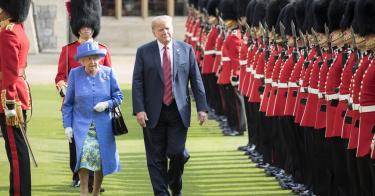The White House announced Tuesday that it has accepted an invitation from Queen Elizabeth II for President Donald Trump and first lady Melania Trump to make a state visit to the United Kingdom.
The president’s visit June 3 to 5 will come as part of commemorations of D-Day, the Allied invasion of German-occupied France that began the liberation of Europe in 1944. But it is also an important opportunity to re-affirm the special relationship between the United Kingdom and the United States.
You might wonder what makes a “state visit” different from a normal one. In the United States, the president is both the head of state and the leader of the government. But many countries split these positions. So in Britain, the queen is the head of state, while the prime minister is the head of the government.
Thus, when the U.S. president visits Britain and meets the prime minister, it’s a regular visit. When the president visits Britain at the invitation of the queen, and has the appropriate ceremonies—in this case, a formal welcome and lunch and dinner at Buckingham Palace—it’s a state visit.
Of course in Britain, the queen, a constitutional monarch, issues her invitations on the advice of the government. So in the end, the decision about who gets a state visit is a political one.
The first couple’s trip to the U.K. in July 2018, during which they met the queen at Windsor Castle, was billed as a working visit.
What’s surprising is how rare it is for presidents of the United States to pay a state visit to the U.K. This will be only the third such visit since 1945, following President George W. Bush’s state visit in 2003 and President Barack Obama’s state visit in 2011.
Presidents as important to the Anglo-American relationship as Harry Truman, Dwight Eisenhower, and Ronald Reagan all visited Britain, but none did so as part of a state visit.
Trump’s state visit also will include a ceremony marking the 75th anniversary of D-Day at Portsmouth, a city on the English south coast that was an important embarkation point for Allied forces.
After the president and first lady finish the British leg of the trip, they will travel to France at the invitation of French President Emmanuel Macron to participate in D-Day commemorations in Normandy.
Because of the demands of protocol, a state visit has a higher than normal proportion of ceremony. Working time will be reduced as a result.
Discussions likely will center on Brexit, Britain’s ongoing effort to exit the European Union, and the president can be expected to reiterate his and his administration’s welcome pledges that the U.K. stands “at the front of the queue” for a major U.S. trade deal post-Brexit.
The relationship between the U.S. and Britain is deep and close. That doesn’t mean that we agree on everything.
Leaders as close personally and as ideologically aligned as Reagan and Margaret Thatcher disagreed from time to time, and clear points of difference exist between Trump and the current prime minister, Theresa May.
We can count on the media to enumerate every one of these, and to play them up, as the president’s state visit approaches.
Remember: Nations, like people, agree easily only when nothing serious is at stake. Differences about things that matter are the mark of a relationship that mattered 75 years ago in Normandy, and that matters to the U.S., Britain, and the world.
This piece originally appeared in The Daily Signal



